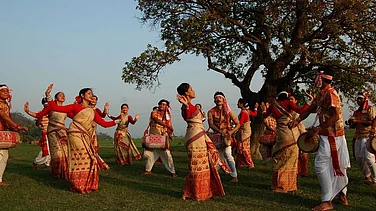Teej is one of those festivals that fills the air with joy, devotion, and a deep connection to nature. The smell of wet earth, the green bangles, the sound of folk songs in the background, and the sight of swings tied to trees remind many of childhood and community celebrations. At its heart, Teej is a festival about love, commitment, and nature. And today, more than ever, it is becoming a celebration of our responsibility toward the environment too.
Traditionally, Teej is observed by women who fast and pray for the well-being of their husbands or a good life partner. They wear green sarees, apply mehendi, sing folk songs, and gather with other women to celebrate. But in recent years, many have added another layer of meaning to Teej by using it as a time to reconnect with nature.
Celebrating with Trees and Swings
In the past, Teej celebrations would often take place under the shade of large trees. Girls and women would swing from branches, sing songs, and enjoy the monsoon breeze. These swings, often decorated with flowers and colorful cloth, were a symbol of joy and renewal.
In urban areas, where trees have been replaced by concrete, this tradition is fading. But some families are bringing it back in a new way. Instead of only tying swings, they are planting trees during Teej. It has become a meaningful ritual that goes beyond devotion to include care for the earth.
Some women plant a tree every year on Teej as a part of their celebration. Community groups and schools also organize collective tree plantation drives, making Teej a time for both spiritual and environmental awareness.
Government Support for a Greener Teej
In Rajasthan, the government took a remarkable step in 2024 to connect Teej celebrations with environmental goals. On Hariyali Teej, the Chief Minister’s tree plantation campaign set a target to plant over one crore trees in a single day. Chief Minister Bhajan Lal Sharma inaugurated the forest festival at the SDRF campus in Gadota, Dudu, to launch this initiative.
According to Forest Minister Sanjay Sharma, the plan was to plant seven crore trees during the monsoon season and geo-tag each one to monitor its growth. On that day alone, ten thousand saplings were planted on fifteen hectares of land. This massive drive added a new layer of meaning to Teej, showing how public celebrations can also serve larger environmental causes.
Simple Ways to Go Green at Home
Even without large-scale efforts, individuals can make a difference through small steps. Many women now choose eco-friendly ways to perform Teej rituals. Instead of plastic items, they use earthen diyas, fresh flowers, and banana leaves. This not only reduces waste but also brings back the beauty of traditional practices.
Food prepared during Teej can also be more sustainable. Families are choosing locally sourced, seasonal ingredients to prepare homemade sweets and snacks. This supports local farmers and reduces the carbon footprint of processed food.
Clothing is another area where mindful choices are making a difference. Instead of synthetic fabrics, many are opting for handloom, khadi, or natural fibers. This helps local artisans and promotes sustainable fashion.
Teaching the Next Generation
One of the most heartwarming changes is the involvement of children in these green traditions. Parents are encouraging kids to help plant trees, decorate eco-friendly swings, and learn about the environment. Schools are also taking part by organizing drawing competitions, storytelling sessions, and educational programs around Teej and nature.
These small but meaningful activities help children understand the values behind the festival and develop a sense of responsibility toward the environment.
Devotion That Grows Like a Tree
The story behind Teej is rooted in the deep devotion of Goddess Parvati, who prayed and meditated to be united with Lord Shiva. Her patience, strength, and unwavering love are what make Teej so special.
In a way, planting a tree is also an act of patience and faith. Like love, a tree takes time to grow. It needs care, attention, and trust that one day it will provide shade and shelter. That is why combining Teej with tree plantation is such a powerful gesture. It ties the message of the festival with a deeper commitment to life and the planet.
Looking Ahead
Teej is no longer just a festival about fasting and rituals. It is evolving into a celebration of harmony, balance, and environmental consciousness. As we face challenges like climate change and pollution, turning our festivals into green events is not only wise but also necessary.
This year, as you wear green bangles, sing songs, and swing under the sky, think about what else you can do to make your celebration kind to the earth. Whether it is planting a tree, avoiding plastic, or simply teaching your child a folk song about rain, every small step matters.
Teej is a reminder that love is not just about people. It is also about the world we share. And the best way to celebrate it might just be by giving something back to nature.



























